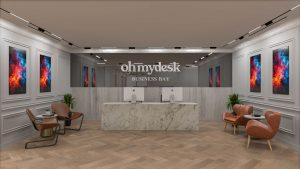Why and How to Encourage Employees to Return to the Office?
The pandemic has significantly altered our working environment, firmly establishing remote work as the new standard. However, the transition back to the office is far from being a simple reversal of these changes. It has evolved into a crucial and complex challenge for businesses as they strive to redefine the role of the physical workspace in a post-pandemic world.
The question now is: How can we revitalize the office environment to make it not just functional but also a desirable place for employees to return to? OhMyDesk, in collaboration with several leading media outlets in Dubai, is proud to introduce a groundbreaking new concept that delves deeply into this very question. This comprehensive analysis not only examines the current trends in workplace transformation but also provides actionable solutions that can be implemented to create a more attractive and efficient office environment. In this white paper, we explore these ideas in depth and present key takeaways that can help you begin the journey of transforming your workspace into a modern, appealing, and productive environment.
1. The Office as the Epicenter of Social Interaction
The office is no longer just a place where work gets done; it should be envisioned as a vibrant social hub. In today’s context, the office must evolve into a space where employees can engage with each other in meaningful ways, beyond just professional interactions. Research indicates that 66% of companies are redesigning their offices to accommodate new hires, while 50% are doing so to encourage employees to return to the office. This shift reflects a growing recognition that social connections fostered within the office environment are critical to team cohesion and overall company culture. The challenge lies in creating an environment that is not only conducive to work but also enhances informal interactions and strengthens the bonds between colleagues. Discover how forward-thinking companies are reimagining their office spaces to cultivate a sense of community and collaboration, making the return to the office an experience that employees look forward to.
2. A Multi-Functional Office for Modern Needs
The contemporary office must evolve to offer more than just a workspace; it should provide a variety of services that make employees’ lives easier and more convenient. From facilities that allow employees to pick up packages to on-site gyms and food trucks, the modern office should be a place where convenience meets comfort. This all-in-one approach ensures that employees can manage their personal and professional tasks seamlessly, thus making the office an integral part of their daily routine. A well-equipped and versatile workspace not only serves as a productivity hub but also enhances employee satisfaction by addressing their holistic needs. This shift towards a service-oriented office design reflects the changing expectations of the workforce, where the workplace must offer more than just a desk—it must provide a comprehensive experience that supports the employee’s work-life balance.
3. Creating an Office That Surpasses Home Comfort
To encourage employees to return to the office, the workspace must offer conditions that are not just on par with, but surpass the comfort of working from home. This involves more than just providing a comfortable chair and desk; it requires a holistic approach to office design that takes into account natural light, air quality, ergonomic furniture, and dedicated relaxation spaces. These elements are critical in creating an environment that promotes both productivity and well-being. OhMyDesk’s approach to office design is a perfect example of this philosophy, emphasizing continuous improvement based on user feedback to ensure that the workspace remains in tune with the evolving needs of employees. By creating an office environment that is not only comfortable but also optimized for performance, companies can foster a culture of productivity and satisfaction.
4. Flexibility in Design and Functionality
Flexibility has become a non-negotiable aspect of modern work culture. Employees today are looking for a balance between the autonomy of working from home and the collaborative opportunities offered by the office. This balance requires workspaces that are not only flexible in design but also adaptable to the changing needs of the workforce. The concept of the flex office, when implemented correctly, provides this much-needed flexibility. It allows for a fluid use of space, where employees can choose their work setting based on their tasks for the day, whether it’s a quiet corner for focused work or a collaborative space for team meetings. This flexibility ensures that the office remains relevant and responsive to the diverse needs of the workforce, making it a place where every employee can find their own way of being productive.
5. Eco-Friendly and Inclusive Workspaces
As companies look to the future, there is a growing emphasis on creating workspaces that are both environmentally sustainable and inclusive. Employees are increasingly concerned with the impact of their workplace on the environment, as well as the inclusivity of the spaces they work in. Reducing the carbon footprint of office buildings and designing spaces that are accessible to everyone, regardless of their physical abilities, are no longer optional—they are essential. OhMyDesk is at the forefront of this movement, committed to creating office environments that are not only sustainable but also reflective of the diverse needs of the modern workforce. By integrating eco-friendly practices and inclusive design principles into the fabric of their office spaces, companies can demonstrate their commitment to corporate social responsibility and create a workplace where all employees feel valued and supported.
Final Thoughts
The return to the office requires more than just opening the doors; it demands a thoughtful approach to space design, service integration, and a deep understanding of the new expectations of the workforce. Today’s offices must transform into dynamic, flexible, and environmentally conscious spaces that go beyond the traditional concept of a workplace. They must become places where employees feel motivated, engaged, and supported in every aspect of their professional lives.
